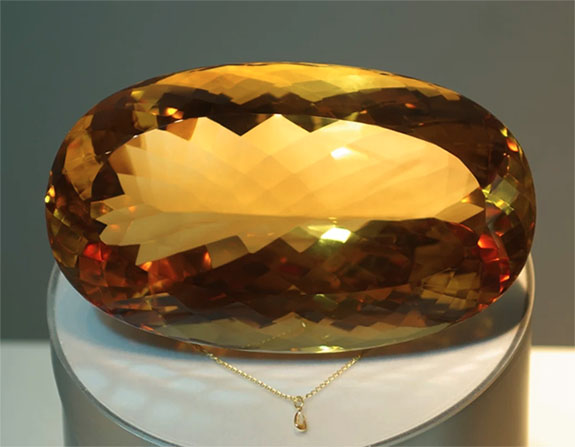The sunny yellow November birthstone you see here is the world’s largest faceted citrine — an oval-cut, 20,200-carat marvel that vanished from the public eye in 2012.
Named for what was once its host city, the “Malaga” had been selected as one of the “Special Exhibition Gems” of the Programa Royal Collections. It was 2010, and the curated collection of 24 world-class gems was expected to attract huge crowds to the Art Natura Malaga, a natural science museum on Spain’s Costa del Sol.
The mammoth rough citrine crystal that would be transformed into the Malaga was unearthed in Mina Gerais, Brazil, in 1990. Due to the risks, complexity and special equipment required to cut and polish the stone, it remained in its original form for 19 years. Finally, in 2009, a team of Brazilian gem cutters took on the formidable challenge of shaping the stone — with startlingly beautiful results.
Rarely does nature present a citrine crystal that could yield such a large faceted stone. Typically, citrine crystals are found in geodes and measure just a few centimeters in size. When they are found in larger formations, the quality is usually lacking and those specimens are used as decorative items.
The internally flawless Malaga citrine measured 20 x 15 x 10 centimeters (7.87 x 5.90 x 3.93 inches) and was set to take up permanent residency at Art Natura alongside other extraordinary citrines, including the previous record holder, the oval-cut, 8,200-carat “Sol del Sur” (Southern Sun) and the 6,705-carat, emerald-cut “Soledade” (Solitude).
Art Natura boasted one of the world’s largest collections of museum-quality gemstones. In all, the collection comprised more than 500,000 carats, and each gem represented the best in its class in terms of size, purity and color.
All the excitement surrounding the opening of Art Natura Malaga came to a screeching halt during the fall of 2012, when legal disputes between the museum's owners and the Malaga City Council forced the complex to close.
Art Natura Malaga continues to have a website and a Facebook page, but both properties seem to be stuck in November of 2012. Sadly, the internet hasn't provided any clues as to the whereabouts of the Malaga citrine or its supersized citrine cousins. In the meantime, we'll just have to relish that special time a decade ago when the Malaga citrine was a rock star.
Credit: Courtesy photo by Programa Royal Collections, 2010.

No comments:
Post a Comment